Zalman F1 120 GB Solid State Drive Review

Can a well-known cooling product manufacturer roll out a good SSD? Yes, he can, because the second generation SandForce platform paved a very short route to the SSD market for those interested.
Solid state drives have made up one of the most rapidly developing segments of the computer component market. The number of SSD products has been growing along with the number of brands offering them. Some of those brands are quite surprising, just like the recent news that Zalman, the well-known Korean maker of cooling systems, has joined their ranks. The news is interesting, so we’ve managed to get a 120GB SSD from Zalman’s F1 series which features the popular SandForce SF-2281 controller.
Yes, it’s rather odd to see an SSD sport the brand of a renowned manufacturer of coolers, system cases and power supplies, yet this might have been expected, really. Zalman has been making attempts to expand its product range in different ways. For example, Zalman’s 3D monitors have long been on the market and the company has also voiced its plans to start making graphics cards as well. Considering this diversification trend, Zalman’s entering the SSD market makes sense. After all, SSDs are the kind of computer components that are extremely simple to develop and manufacture.
Today, producing SSDs is similar to any assembly-line manufacture. This is largely thanks to SandForce which offers its second-generation SSD controllers along with a full-featured platform for assembling SSDs that supports different types of flash memory and includes a reference PCB as well as firmware. Thus, it only takes assembly workers to start your SSD manufacturing business as you won’t need qualified developers, engineers or programmers. It’s even simpler than to manufacture graphics cards based on reference design because there are fewer chips and other components that need to be soldered to PCBs. So, the only problem for SSD market newcomers is to find customers. Zalman should have no problems with that, however. Besides a recognized brand with good reputation, the company also has a well-developed distribution network. We won’t be surprised to see Zalman’s F1 series SSDs become as broadly available as products from old-time SSD market players.
On the other hand, Zalman could not have come up with an original product. The F1 series is likely to be similar to many other SSDs from competitor brands that are based on the SandForce platform, too. Zalman’s promo materials want us to think differently, though.
In this review we will see if the Zalman F1 series is indeed faster than other SandForce-based SSDs by benchmarking the 120GB SSD0120F1 model.
Closer Look at Zalman F1 SSD0120F1 (120GB)
Besides the F1 series, Zalman’s other SSDs are not high-performance products. They are equipped with SATA 3 Gbit/s interface and feature slower controllers from JMicron and Phison. The F1 series, on the contrary, includes fast and modern SSDs based on the second-generation SandForce platform. As opposed to many other makers, Zalman doesn’t provide too many models within it. The F1 series is comprised of only three products with storage capacities of 60, 120 and 240 gigabytes. We’ve got the midrange model for our tests.
The Zalman F1 series comes in a small cardboard box of sober design. The series name seems to refer to Formula 1 racing but we don’t see such motifs in the product packaging. Moreover, the series is referred to as just F rather than F1, so we can expect Zalman to produce F2, F3 and other such SSD series in the future.
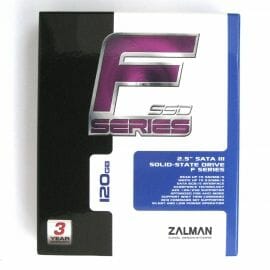
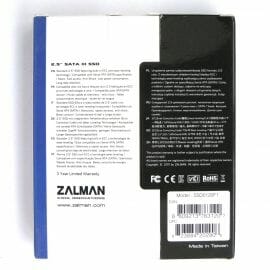
The product specs you can read from the front panel of the box are just what you can expect from a SandForce-based SSD. We can only note that the peak read and write speeds are very high: 560 and 530 MB/s, respectively. That’s very boastful as even OCZ’s Vertex 3 has lower performance specs. It’s either Zalman knows some technological secret or Zalman’s marketing department has no shame. Our tests will show.
Besides the SSD, the box contains a user manual from which you can learn that the manufacturer offers you to download Acronis True Image HD for free. The utility’s serial number is on the sticker attached to the SSD.
There is nothing extraordinary about the SSD’s design. It’s a black metallic brick of the 2.5-inch form factor that lacks any originality. Its appearance is somewhat enlivened by the black glossy sticker with specs, part number and a large fuchsia-colored F series logo.
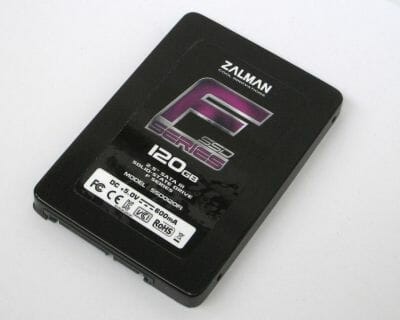
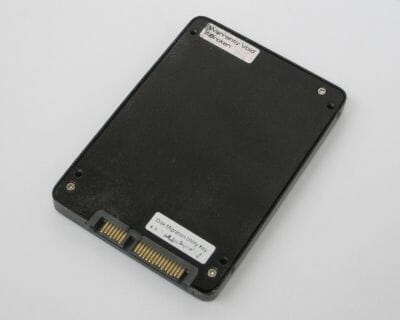
Well, SSDs are not bought for their looks. It’s far more important what’s inside that black box.
The PCB we found inside our 120-gigabyte Zalman F1 carries a standard second-generation SandForce SF-2281 controller and 16 chips of NAND flash memory manufactured by Intel. Labeled 29F64G08ACME3, such memory chips were also installed in our sample of Corsair’s Force GT 120GB. Thus, the Zalman F1 is a typical SandForce-based SSD with 25nm synchronous MLC flash memory with ONFI 2.2 interface. It uses 2-way interleaving, just like other 120GB SSDs.
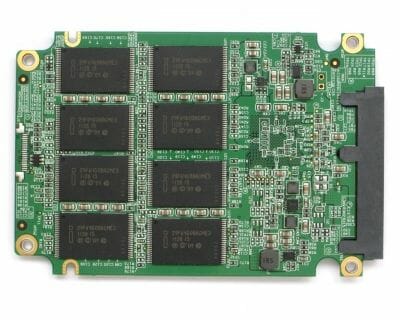
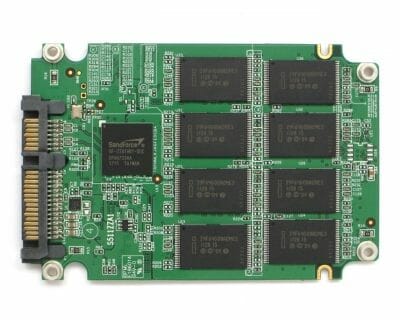
Looking at the hardware components, it is difficult to see why the Zalman F1 should be faster than other 120GB SandForce-based SSDs with synchronous flash. It seems to be no different from other products of its class such as the Corsair Force Series GT, Kingston HyperX, OCZ Vertex 3 and ADATA S511.
There is a possibility that Zalman introduced some substantial changes into the firmware, yet we doubt it. The more tests of SSDs with the SF-2281 controller we carry out, the more proof we have that their performance is only influenced by the type of NAND flash employed. Moreover, the Zalman F1’s firmware seems to be similar to the reference SandForce 3.3.2 firmware and even has the same version number.
Anyway, the increased read and write speeds are written into the official Zalman F1 120GB specs:
- Controller: SandForce SF-2281
- Interface: SATA 6 Gbit/s
- Flash memory: synchronous 25 nm NAND
- Capacity: 120 gigabytes
- Cache memory: none
- Sequential read speed: 560 MB/s
- Sequential write speed: 530 MB/s
- Random write speed (in 4 KB data blocks): no data.
Like many respectable SSD makers, Zalman provides a 3-year warranty for its products.
Testbed and Methods
The special testbed we are going to use for this test session is based on a mainboard with Intel H67 chipset which offers two SATA 6 Gbit/s ports. We connect our SSD testing participants to these particular ports.
We will compare Zalman F1 120 GB SSD against three other SandForce based products with the same storage capacity, which represent three different platforms: Patriot Wildfire is based on 32 nm Toggle NAND, Corsair Force Series GT is based on 25 nm synchronous memory, and Corsair Force Series 3 is an SSD with asynchronous memory. Besides, we also included 240 GB SSD models from Corsair Force Series GT and Corsair Force Series 3, as well as a 256 GB Crucial m4 with a Marvell controller inside.
Here is the full testbed configuration:
- Intel Core i5-2400 (Sandy Bridge, 4 cores, 3.1 GHz, EIST and Turbo Boost turned off);
- Foxconn H67S mainboard (BIOS A41F1P01);
- 2 x 2 GB DDR3-1333 SDRAM DIMM 9-9-9-24-1T;
- Crucial m4 256 GB system disk (CT256M4SSD2);
- Tested SSDs:
- Corsair Force 3 Series 120 GB (CSSD-F120GB3-BK, firmware version 1.3.3);
- Corsair Force GT Series 120 GB (CSSD-F120GBGT-BK, firmware version 1.3.3);
- Corsair Force 3 Series 240 GB (CSSD-F240GB3-BK, firmware version 1.3.3);
- Corsair Force GT Series 240 GB (CSSD-F240GBGT-BK, firmware version 1.3.3);
- Crucial m4 256 GB (CT256M4SSD2, firmware version 0009);
- Patriot Wildfore 120 GB (PW120GS25SSDR, firmware version 3.3.2);
- Zalman F1 120 GB (SSD0120F1, firmware version 3.3.2).
- Microsoft Windows 7 SP1 Ultimate x64
- Drivers:
- Intel Chipset Driver 9.2.0.1030
- Intel HD Graphics Driver 15.22.1.2361
- Intel Management Engine Driver 7.1.10.1065
- Intel Rapid Storage Technology 10.8.0.1003.
Performance
Random and Sequential Read/Write Speed of FOB Drive
We benchmark the speed of random- and sequential-address reading and writing with CrystalDiskMark 3.0.1 test. This benchmark is convenient to work with as it can measure the speed of an SSD with both random incompressible and fully compressible recurring data. So, there are two numbers in the diagrams below that reflect the maximum and minimum SSD speed. The real-life performance of an SSD is going to be in-between those two numbers depending on how effectively the SF-2281 controller can compress the data.
The performance tests in this section refer to SSDs in their “fresh” out-of-the-box state (FOB). No degradation could have taken place yet.
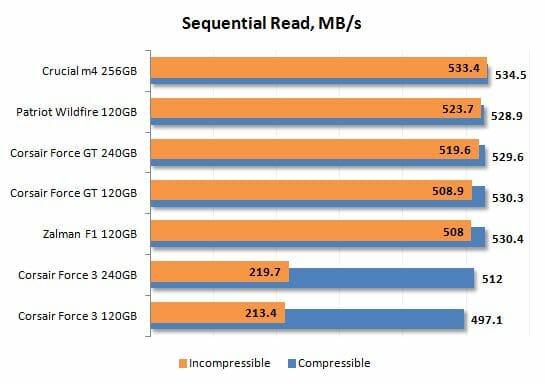
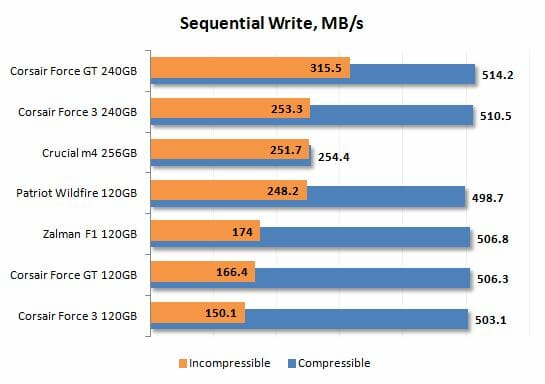
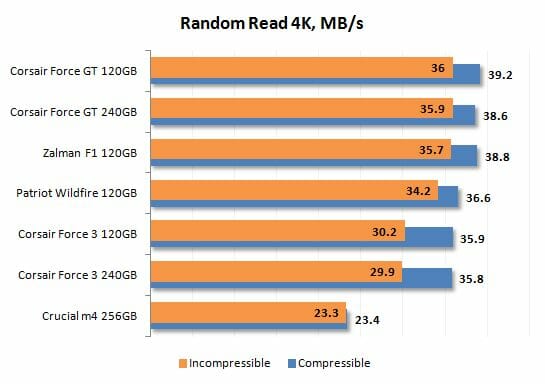
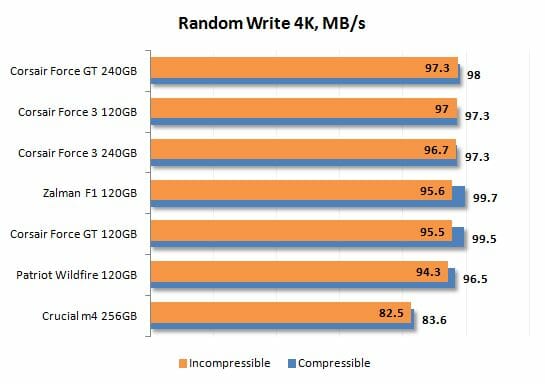
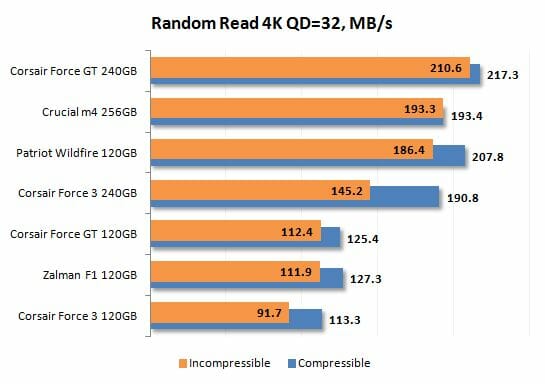
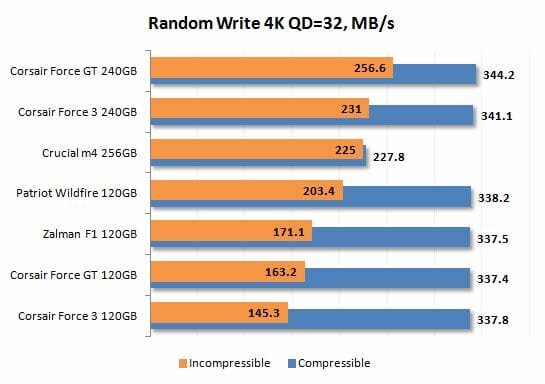
We can see that the Zalman F1 cannot meet its specifications in terms of sequential read speed. This SSD turns out to be no faster than any other SF-2281 based drive with synchronous flash. The Zalman F1 is similar to the Corsair Force GT in every key parameter, being faster than low-end products with asynchronous flash like the Corsair F3, but slower than toggle-NAND products like the Patriot Wildfire. It is also expectedly slower than the large-capacity SSDs. Its 240GB cousin is going to be faster, too, thanks to 4-way interleaving.
Degradation and Consistent Performance
Unfortunately, SSDs are not always as fast as in their “fresh” state as they should be. In most cases their performance goes down after some time and in real life we deal with completely different write speeds than what we see on the diagrams in the previous chapter of our review. The reason for this phenomenon is the following: as the SSD runs out of free pages in the flash memory, its controller has to clear memory page blocks before saving data into them, which causes substantial delays. On the other hand, modern SSD controllers can alleviate the performance hit by erasing unused flash memory pages ahead of time, when idle. They use two techniques for that: idle-time garbage collection and TRIM.
Of course, users are more interested in the consistent performance of their SSDs over a long period of time rather than the peak speed they are going to see only during the initial short-term usage period. The SSD makers, however, declare the speed characteristics of “fresh” SSDs for marketing reasons. That’s why we decided to test the performance hit that occurs when a “fresh” SSD becomes a “used” one.
To get a complete picture of SSD performance degradation we ran special tests based on the SNIA SSSI TWG PTS (Solid State Storage Performance Test Specification) methodology. The main idea of this approach is to measure write speed in four different cases. First we measure the “fresh” SSD speed. Then we measure their speed after the SSD has been fully filled with data twice. The third test occurs after a 30-minute break during which the controller can partially restore performance by running the idle-time garbage collection. And finally, we measure the speed after issuing a TRIM command.
We ran the tests in synthetic IOMeter 1.1.0 RC1 benchmark, where we measured random write speed when working with 4KB data blocks aligned to flash memory pages at 32 requests queue depth. The test data were pseudo-random.
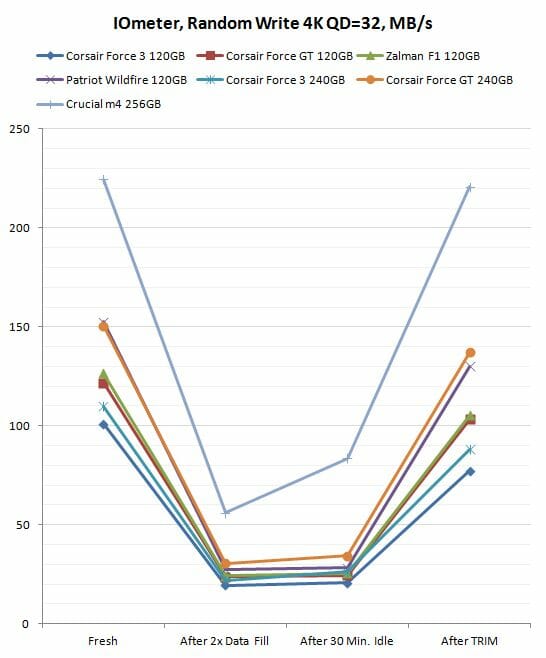
SSDs with SF-2281 controller have a considerable performance hit at writing. Unfortunately, they never return to their fresh-state performance notwithstanding the mentioned techniques against degradation. The Zalman F1 is no exception, behaving exactly like its opponent Corsair Force GT. This performance degradation is a shame especially as the Crucial m4, based on a Marvell controller, shows that an SSD’s performance can indeed be restore by the TRIM command.
It means that the write speeds shown in the diagrams in the previous section of our review only reflect but a fragment of the overall picture. As soon as fresh SSDs turn into used ones, their performance changes completely. Their write speed is different. The next diagrams show this speed as benchmarked by CrystalDiskMark 3.0.1.
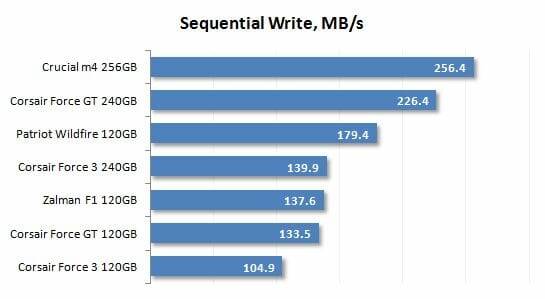
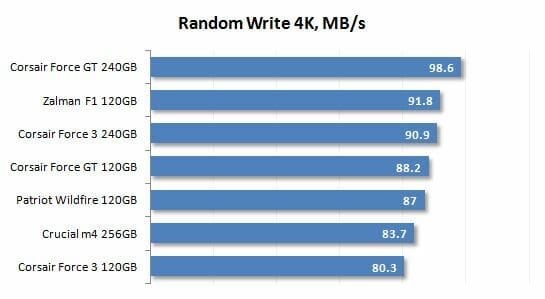
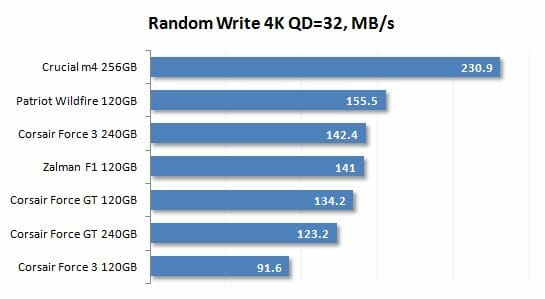
The SandForce-based SSDs slow down but the overall picture remains the same. The Zalman F1 doesn’t show any sign of its promised superiority over competitors.
Futuremark PCMark 7
PCMark 7 contains an individual disk subsystem benchmark. It is not a synthetic test, but is based on real-life applications. This benchmark reproduces typical disk usage scenarios and measures how fast they are completed in popular applications. Moreover, the disk access commands are not executed as a steady uninterrupted flow, but in a more realistic manner – with certain pauses caused by the need to process the data. The benchmark generates an overall disk subsystem performance rating as well as speed readings in MB/s in particular usage scenarios. Note that the absolute speed in these scenarios is not too high because of the above mentioned pauses between individual input/output operations. In other words, PCMark 7 shows you the speed of the disk subsystem from the application’s point of view. Numbers like that show us not only the pure performance of an SSD, but mostly how big of a performance gain a certain SSD can guarantee in real life.
We ran PCMark 7 on “used” SSDs, which is what they are going to be in actual computer systems most of the time. Their performance is in this case affected not only by their controller or flash memory speed but also by the efficiency of their internal algorithms that fight performance degradation.
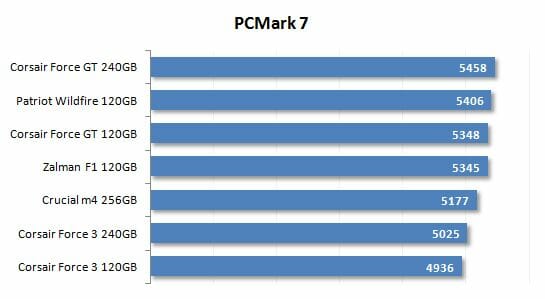
The overall PCMark 7 score can serve as an intuitive benchmark for users who want to know the relative standings of SSDs in terms of performance but do not care about learning the technical details. According to this test, the 120GB Zalman F1 delivers average performance and is similar to the Corsair Force GT which, in its turn, is alike to the OCZ Vertex 3 and Kingston HyperX as we know from our earlier tests.
You may want to take a look at the individual subtests. The gaps between the contestants are quite impressive in some of them.
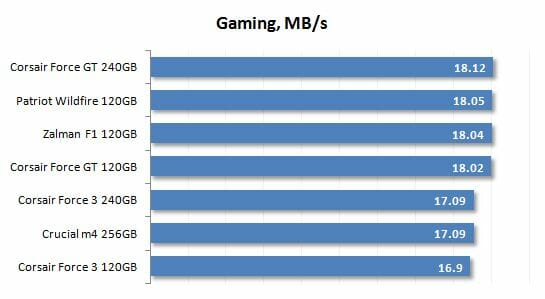
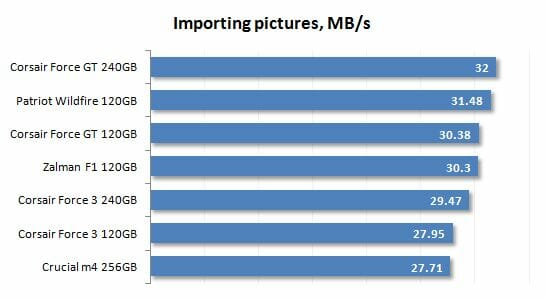
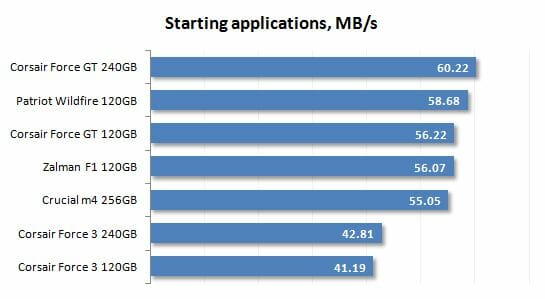
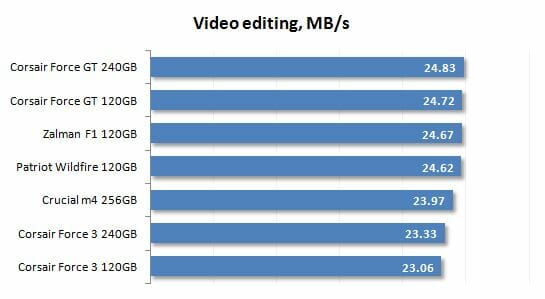
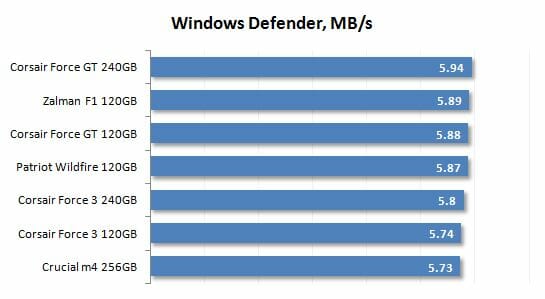
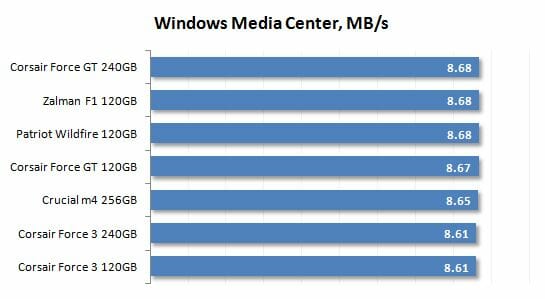
Intel NAS Performance Toolkit
Intel NASPT is another disk subsystem benchmark that uses real-life usage scenarios. Just like PCMark7, it reproduces predefined disk activity patterns and measures how much time they take to be performed. Together with PCMark7, this benchmark produces an excellent illustration of the disk subsystem’s performance in real-life applications. Just like in the previous case, the SSDs were tested in their “used“ state.
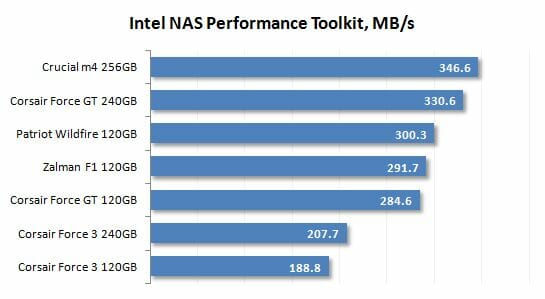
Compared to PC Mark 7, writing has a higher weight in Intel NAS Performance Toolkit, so the standings are somewhat different. Anyway, the 120-gigabyte Zalman F1 delivers the same performance as any other SSD with second-generation SandForce controller and 25nm synchronous MLC flash.
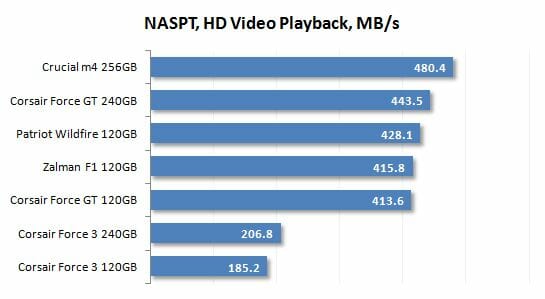
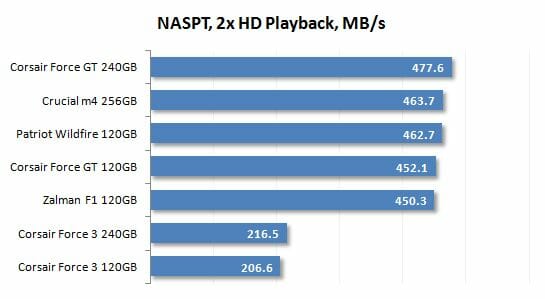
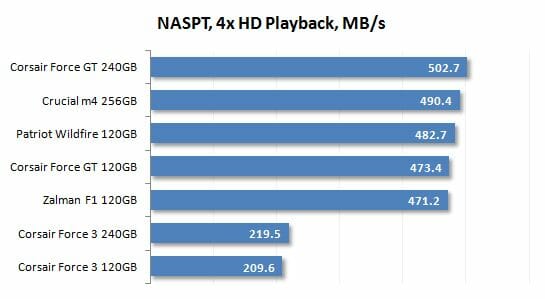
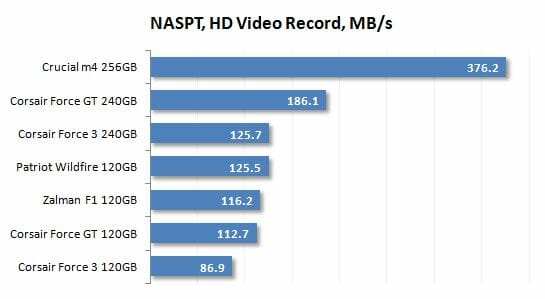
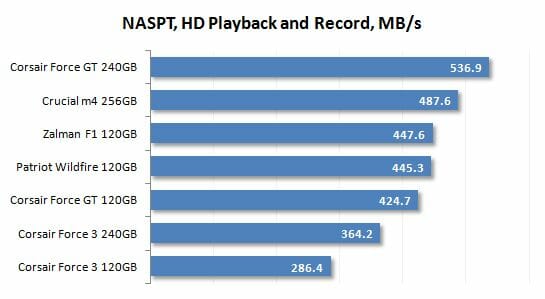
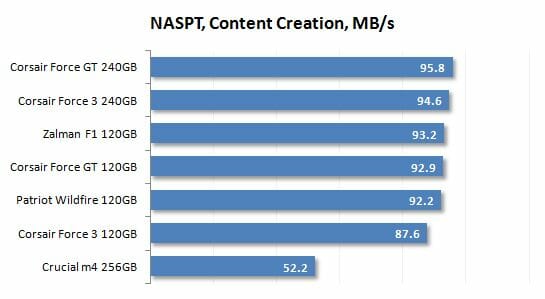
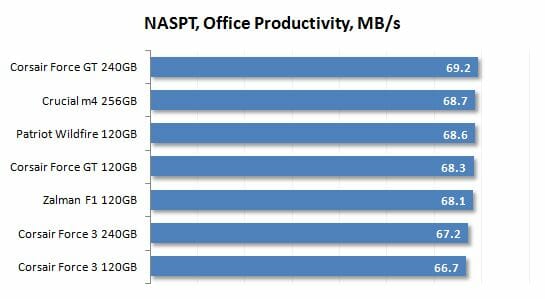
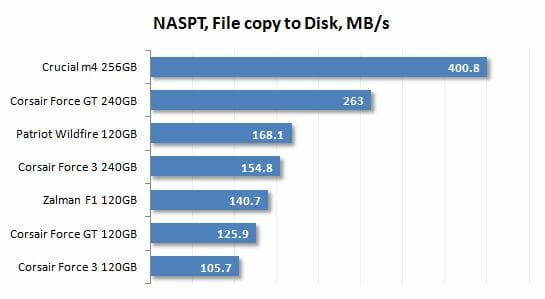
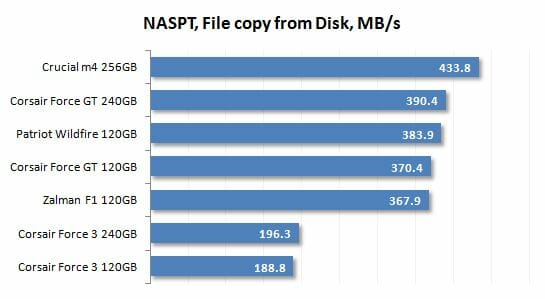
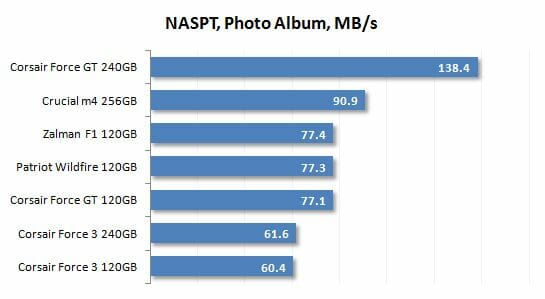
Conclusion
Unfortunately, Zalman’s claims that their new “racing” SSD is faster than competitors are not well-grounded. In fact, the Zalman F1 is an ordinary SSD based on the SandForce platform. It is a fast and high-quality product but no better than similar SSDs offered by other brands.
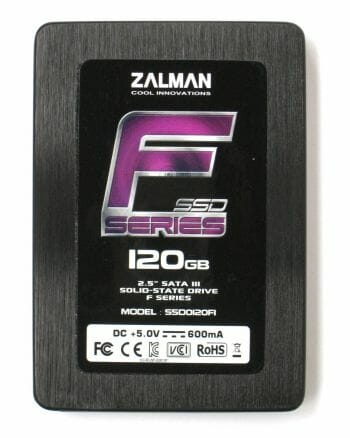
Generally speaking, our tests of numerous SSDs based on SF-2281/SF-2282 controllers suggest that their speed depends only on the type of flash memory employed. Take two SSDs with a second-generation SandForce controller, identical capacities and identical flash memory type, and they are going to deliver the same performance both in benchmarks and real-life applications. Firmware optimizations that might theoretically affect performance do not do so in practice. Intel’s upcoming 520 series may become an exception, but so far we haven’t seen any.
Thus, you can get an accurate notion of performance of an SSD with a second-generation SandForce controller without any tests by simply looking up its flash memory type.
We can put together all SandForce-based SSDs into a single table and see that they fall into three groups in terms of performance. They do not differ much in terms of speed within each group, but the different groups do perform differently.
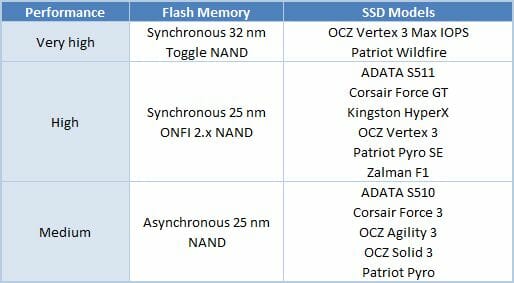
The Zalman F1 is just another mainstream SandForce-based SSD. Its speed is similar to that of many popular products. It comes with the latest firmware, which is expected to be stable and problem-free, and has a standard 3-year warranty. If Zalman puts an attractive price tag on this SSD, provides good tech support and ensures broad availability, the F1 can become quite a bestseller.